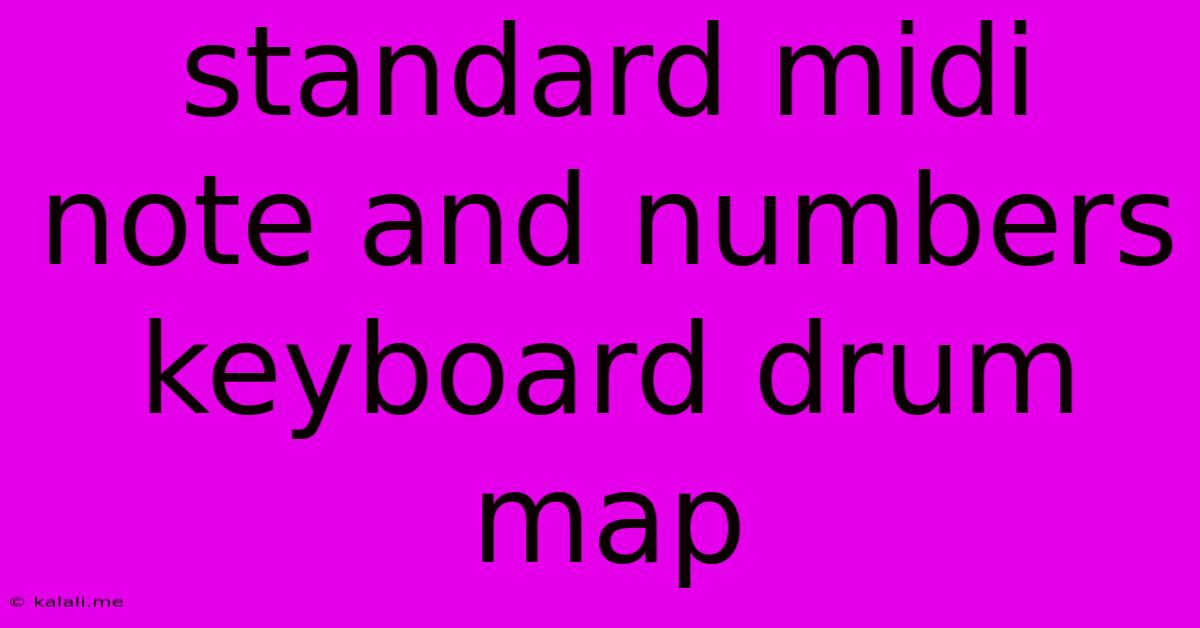Standard Midi Note And Numbers Keyboard Drum Map
Kalali
Jun 09, 2025 · 4 min read

Table of Contents
Standard MIDI Note Numbers: Your Keyboard to Drum Machine Mapping Guide
Understanding MIDI note numbers is crucial for anyone working with digital audio workstations (DAWs), drum machines, synthesizers, or any MIDI-based music software. This comprehensive guide will break down the standard MIDI note numbers for drums and percussion instruments, providing a clear mapping for your keyboard or MIDI controller. Knowing this will unlock a world of creative possibilities, letting you program beats, sequences, and rhythms with precision.
This article will delve into the common MIDI note numbers associated with various drum sounds, allowing you to efficiently program your drum kits and integrate them seamlessly into your musical productions.
What are MIDI Note Numbers?
MIDI (Musical Instrument Digital Interface) uses a numerical system to represent musical notes. Each note on a standard 88-key piano keyboard, and beyond, is assigned a unique MIDI note number, starting from C-1 (note number 0) and extending far beyond the range of a typical piano. This numerical system allows different MIDI devices to communicate effectively regardless of their physical layouts or instrument types.
Drum sounds, while not traditionally thought of as notes in the musical scale, also utilize MIDI note numbers to trigger specific sounds within a drum kit.
The Standard MIDI Drum Map (General MIDI)
The General MIDI (GM) standard defines a common set of sounds and their corresponding MIDI note numbers. While variations exist, the following table represents the most commonly accepted mapping for drum and percussion sounds:
| MIDI Note Number | Instrument | Common Name |
|---|---|---|
| 35 | Acoustic Bass Drum | Kick Drum |
| 36 | Bass Drum 1 | Kick Drum |
| 37 | Side Stick | Side Stick |
| 38 | Acoustic Snare | Snare Drum |
| 39 | Hand Clap | Hand Clap |
| 40 | Electric Snare | Snare Drum (Electric) |
| 41 | Low Floor Tom | Low Tom |
| 42 | Closed Hi-Hat | Closed Hi-Hat |
| 43 | High Floor Tom | High Tom |
| 44 | Pedal Hi-Hat | Open Hi-Hat |
| 45 | Low Tom | Low Tom |
| 46 | Open Hi-Hat | Open Hi-Hat |
| 47 | Low-Mid Tom | Low-Mid Tom |
| 48 | High Mid Tom | High-Mid Tom |
| 49 | Crash Cymbal 1 | Crash Cymbal |
| 50 | High Tom | High Tom |
| 51 | Ride Cymbal 1 | Ride Cymbal |
| 52 | Chinese Cymbal | Chinese Cymbal |
| 53 | Ride Bell | Ride Bell |
| 54 | Tambourine | Tambourine |
| 55 | Splash Cymbal | Splash Cymbal |
| 56 | Cowbell | Cowbell |
| 57 | Crash Cymbal 2 | Crash Cymbal |
| 58 | Vibraslap | Vibraslap |
| 59 | Ride Cymbal 2 | Ride Cymbal |
| 60 | High Bongo | High Bongo |
| 61 | Low Bongo | Low Bongo |
| 62 | Mute High Conga | Mute High Conga |
| 63 | Open High Conga | Open High Conga |
| 64 | Low Conga | Low Conga |
| 65 | High Timbale | High Timbale |
| 66 | Low Timbale | Low Timbale |
| 67 | High Agogo | High Agogo |
| 68 | Low Agogo | Low Agogo |
| 69 | Cabasa | Cabasa |
| 70 | Maracas | Maracas |
| 71 | Short Whistle | Short Whistle |
| 72 | Long Whistle | Long Whistle |
| 73 | Short Guiro | Short Guiro |
| 74 | Long Guiro | Long Guiro |
| 75 | Claves | Claves |
| 76 | Hi Bongo | Hi Bongo |
| 77 | Low Bongo | Low Bongo |
| 78 | Mute High Conga | Mute High Conga |
| 79 | Open High Conga | Open High Conga |
| 80 | Low Conga | Low Conga |
Mapping to Your Keyboard
This table allows you to easily map your MIDI keyboard to your drum sounds. For example, pressing the key corresponding to MIDI note number 36 on your keyboard will trigger the bass drum sound. Remember that this mapping is dependent on your DAW or drum machine's configuration. You might need to adjust the mapping within your software's settings.
Beyond the Standard: Expanding Your Drum Kit
While the General MIDI standard provides a foundation, many drum machines and sample libraries offer vastly expanded sets of percussion instruments and sounds, often extending beyond note number 80. Explore the capabilities of your specific software or hardware to unlock a wider range of sounds and creative possibilities.
This understanding of standard MIDI note numbers will significantly enhance your workflow and allow for more precise and creative control over your drum programming and MIDI sequencing. Experiment with different sounds and combinations to discover your unique drumming style!
Latest Posts
Latest Posts
-
How Long Can A Peanut Butter And Jelly Sandwich Last
Jun 09, 2025
-
How To Change Stats Rpg Maker Mv
Jun 09, 2025
-
Yellow Robot With Display For Face
Jun 09, 2025
-
Type Emojis In Mac Messenger Just Like Slack
Jun 09, 2025
-
Sausage Party Ending Of The Movie
Jun 09, 2025
Related Post
Thank you for visiting our website which covers about Standard Midi Note And Numbers Keyboard Drum Map . We hope the information provided has been useful to you. Feel free to contact us if you have any questions or need further assistance. See you next time and don't miss to bookmark.